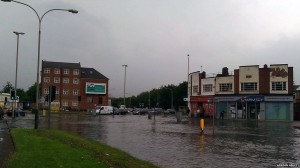Flood Damage: How To Protect Your Business
Flood Damage is no longer a problems for properties in the close proximity to rivers. There is a growing number of businesses suffering water ingress following short sharp showers. Being in a dip is becoming a problem that insurers have spotted through sophisticated terrain mapping.

In Leicester, the junction of Fosse Road North, Groby Road and Blackbird Road was submerged by Floods this week
Even if you are insured, the damage suffered in a serious flood can have disastrous consequences for your business.
You will need to deal with things like: removing debris, cleaning-up costs, lost orders, wasted management time, dissatisfied customers & lost revenue.
Cornerstone Business Insurance Ltd in Leicester have 10 easy ways to help your business survive against flood damage, so here are our Top 10 Tips:
1. Raise the floor –
If you cannot physically raise the level of your premises, make sure that your machinery and stock are raised above the highest recorded flood levels by at least 20 centimetres. The simplest way of raising stock is the use of pallets. If previous flood levels have exceeded this, several levels of pallets may be necessary. By raising stock above the water level, pallets have the additional advantage of allowing the free run off of any accumulated water making natural drainage or pumps far more effective and drying out more efficient.
2. Protect your machinery –
Floodwater can do substantial damage to electrical machinery, causing short circuits and corrosion, which may make delicate machinery irreparable. If your machinery does not operate, your production lines will be down long after the floodwater has receded and your revenue and profitability will fall.
3. Power Supplies –
When floodwater reaches the level of power supply outlets and staff are in danger of being electrocuted. It is essential to raise power supply outlets well above flood levels.
4. Goods in the Open –
If possible, you should ensure all stocks are stored inside warehouses during storms or heavy rains. However, outside storage is often a necessity and is probably safer than storage in basement levels, which are prone to flood. Placing goods in the open on tarpaulins and raising the edges of the tarpaulins to form a waterproof container can protect stocks stored in the open from flood in the same way that tarpaulin covers will protect stocks from rain. The tarpaulins should be carefully inspected to ensure that they are in perfect condition before use.
5. Install pumps –
As water accumulates within a building or compound, it may be necessary to pump out. This may certainly become necessary as floodwater recedes and basement areas need to be cleared to assist drainage and ventilation. Have adequate pumps not just available, but ready, tested, tried and known to operate
6. Basements –
Be prepared for the flood. Clear basement storage areas early, don’t leave it until the last minute
7. Emergency plans and contingency plans –
Make plans to prepare for that undesirable event. With well-written emergency plans, everyone will know what they must do in an emergency. All necessary personnel will be advised and panic will not arise. But planning on its own is not enough. Practice will allow the plan to operate. Regularly test your emergency procedures and review their reliability.
8. Contingency plans
will identify the procedures to be adopted following a catastrophe to return your business operations to normal as quickly as possible. These may include pre-evaluation of alternative premises, availability of key equipment, notification and transportation of staff and even the simple notification to customers and suppliers of a temporary change of address.
9. Clean drains –
Flash flooding can cause substantial damage and is easily avoided. Clear drains of leaves, vegetation and other waste regularly, especially before and if at risk of flooding. Gutter and roof pipes should be regularly checked to ensure they are clear of obstruction and in good condition.
10. Insurance –
Check your policy schedule for details of the flood damage excess and possible cover exclusions. If your policy does have flood terms put together a good case to have the conditions removed – ie mitigating features
Make sure that you are properly insured by speaking to Cornerstone Business Insurance Ltd Tel – 0116 3440040 Mob – 0779 2901 779 Fax – 0116 2240 399
www.cornerstoneinsurance.co.uk
Cornerstone Business Insurance Ltd
19 Warren Park Way Enderby Leicester LE19 4SA